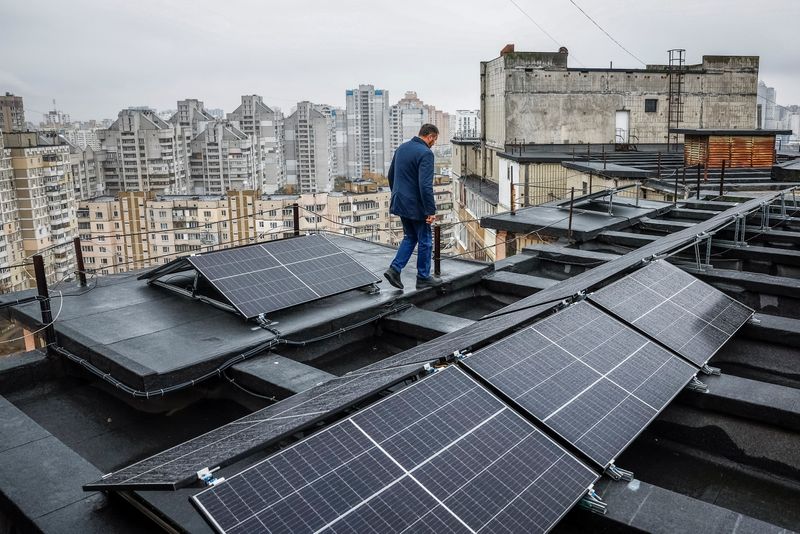By Olena Harmash
KYIV (Reuters) - Standing on the rooftop of a 16-storey residential apartment building in Ukraine's capital Kyiv, Valerii Pyndyk pointed to several rows of solar panels.
Pyndyk hopes the installation - one of the first of its kind by residents in Kyiv - will help about 1,000 families living in the building get through what could prove Ukraine's most difficult winter since the start of Russia's invasion.
"The idea was born when we had electricity cut-offs in summer. We - the housing association board - realised that if we had blackouts in summer, then in winter they will not be shorter but longer," said Pyndyk, 49, who heads the association.
The two previous winters of the war were already challenging, but Russia has now intensified its attacks on Ukraine's energy infrastructure, with at least 11 major missile and drone strikes since March.
About half of Ukraine's generating capacity was knocked out and distribution networks were also damaged.
In Kyiv, daily blackouts of eight hours are common and people plan their days around when power is scheduled to be available, including waiting in cafes for elevators to work if they live near the top of high-rise buildings.
Some residents and businesses have rushed to install new generating capacity in an attempt to access energy independently of the central energy system.
"Overall in Ukraine there is a steady trend towards energy independence, starting from small (consumer) clients and ending with business," said Serhiy Kovalenko, CEO of Yasno, a leading energy supplier.
Analysts said strategies included more electricity imports from Ukraine's Western neighbours, purchases of generators and alternative energy sources including solar panels, batteries and small gas turbine generators.
Yasno, which supplies electricity and gas to more than 3.5 million consumers and up to 100,000 businesses, provides options that include solar panels and accumulating batteries and inverters.
"Demand is very high," Kovalenko told Reuters. "This autumn we installed up to eight megawatts, next year we will install up to 30-35 megawatts."
Eight megawatts is enough to supply around a dozen enterprises in this case, the company said.
SECURITY CONCERNS
Russia has damaged or destroyed all of Ukraine's thermal and hydropower plants.
In monetary terms, total damage to Ukraine's energy sector exceeds $56 billion, including $16 billion in direct physical destruction and over $40 billion in indirect financial losses, according to estimates from the Kyiv School of Economics.
The country has to rely increasingly on nuclear generation, which makes it difficult to balance the amount of electricity on the grid, especially during peak morning and evening hours when retail consumption jumps.
Ukraine has tried to defend its energy system by building protective structures, setting up mobile drone-hunting groups and working with partners to bring in more air defence systems.
But it still lacks sufficient resources to protect facilities across the country.
After each Russian strike, the government, energy companies, engineers and Ukraine's partners scramble to recover and rebuild what they can. Winter weather can complicate matters.
"If we have a cold winter, consumption will be much more than last winter. Last winter, maximum consumption was 18 gigawatts (GW), so this year we think that if it is cold... it will be 19 gigawatts," said Olena Lapenko, general manager for energy security at a Kyiv-based think-tank, DIXI group.
Once the lights go off, the immediate fix for many is to turn on the generators.
"We need this electricity... to bake bread, to make croissants, cakes... We took a lot of steps to be ready – we bought powerful generators," said Stanislav Zavertailo, co-owner of Honey confectioneries and Zavertailo pastry shops in Kyiv.
As his team refuelled an industrial generator at their production site, Zavertailo said electricity was driving up costs.
"One kilowatt-hour is five to six times more expensive than the usual one."
Generators work better for small- and medium-sized enterprises and offer only a temporary solution, analysts said.
Looking for ways to help bigger businesses, the government agreed with Ukraine's central European neighbours to increase imports to 2.1 GW at any given time from Dec. 1. But imports are also expensive, said Lapenko.
PUSH FOR CLEAN ENERGY
Dozens of financial programmes supported by Kyiv's Western allies have been launched to shift Ukraine's energy mix to a cleaner and more sustainable model. Legislative changes were also introduced to simplify equipment purchases and imports.
Solar panels have started to appear on roofs of private houses, residential buildings, schools, hospitals and other public buildings.
Pyndyk said the cost of the installation on his building was about 950,000 hryvnias ($23,000) and that the government and Kyiv municipality had offset about two-thirds of that amount.
He and his residents plan to install more panels on other buildings next year.
Official data showed that about 1.5 GW of new solar generation has been installed. But given Ukraine's needs and the scale of wartime damage to energy infrastructure, such changes are only the beginning.

"This problem is not only a challenge for this winter. Coal generation is outdated and we need to change something," said Lapenko of DIXI group.
"This is the prospect for three, four or five years to replace what was destroyed and gradually replace that outdated generation."